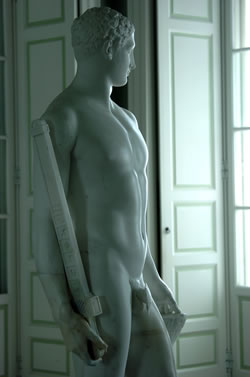PALAMEDE
The project Palamede takes its name from one of the heroes of the Trojan War: Palamedes. He was the king of Euboea, the second largest Greek island; moreover,
he was know to be brave and cunning. He stood out as an inventor: for sure, the most favourite invention among the Greek soldiers besieging Troy was the forefathers of the modern game of the goose.
Soldiers liked so much the new game that lost their interest in war. As a consequence, Odysseus (known also as Ulysses) hurried up to stone Palamedes in order to make up for lost time due to the game, and thus shorten the diffcult campaign on the Trojan sands.

However, the die was invented. Palamedes’ die was made of an astragalus, the small bone that lies between the tibia and fibula of mutton. Nowadays a quite different die is going to be completed.
The modern die is the Palamede satellite: the project started in 1997, and it has required the skills of many students, researchers and professors of the Politecnico di Milano in di erent fields of engineering.
Palamede is classified as a micro–satellite, namely a satellite which mass values lays between 10 kg and 100 kg. Interest in small–satellites (nemely all satellite with mass below 500 kg) is always increasing and it is confirmed, as an example, by the ESA VEGA program for a small launcher, which first flight is planned for 2009.
Small–sats are appealing mainly because of the funds cutting of almost all national space agencies. In fact small satellites allow low costs due to:
- less compless systems, which leads to simpler and faster design and manufacturing processes;
- smaller project team;
- use of industrial components.
- give a didactical opportunity to its students;
- develop the use of industrial (and thus not space qualified) technologies in space;
- develop a multipurpose bus for a wide range of payloads.
From students’ point of view, the project is challenging: it allows to put all the knowledge learnt in years of university into practice in a “controlled test–bed” before starting to work in a company. Even if the project duration probably is not the one thought at the beginning, this lack is fulfilled by the amount of experiences that the project has given to all its partecipants.

